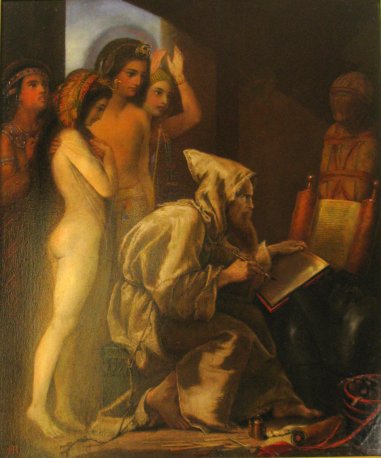Hermit of the Thebaid
Overview
Hermit of the Thebaid [ edit ]
Alexander Rowan, a little-known painter of the mid-nineteenth century British Academic movement, has here imagined a meeting between Egypt’s pharaonic and Christian past. A monk, wearing a rough woolen cloak sits atop an ancient Egyptian chest decorated with uraei and uses a black stone sarcophagus (based on an object in the British Museum) as a table. The monk is translating the Greek New Testament (specifically, the beginning of the Gospel of John) into the northern Coptic dialect and script known as Bohairic. The Greek text is on a scroll, while the monk writes on a “codex”—a book with closing covers and individual pages, a format familiar to us, but new in the fourth century CE.
While the British painter has imagined the Egyptian spirits as curious onlookers, the ancient Coptic author Shenoute could uncomprehendingly speak of hieroglyphs as “prescriptions for murdering man’s soul” written in blood and containing nonsensical depictions of creatures. Rowan’s “Egyptological” gaze rehabilitates the Egyptian spirits and transforms them from the evil pagan souls of Coptic literature into worshippers of an earlier religion that is seen more as a forebearer of later beliefs.
Date
1853
Dimensions
H. 47.5 cm; W. 39.5 cm
Artist or Author
Alexander Rowan
Museum
Private Collection






















